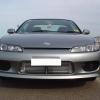Painting Calipers What Is More Durable
Announcements
-
Similar Content
-
Latest Posts
-
I downloaded the apps (for windows) and Consult 1 doesn't have this function on it for the Consult 1 plug which I'm pretty sure all Skylines have. You would think someone would have a workaround after 30 years for all Skylines which have ABS.
-
Also, I don't know the actual ABS system on the skylines, but a sneaky thing could be a piece of electronic equipment that makes the ABS think you're moving, and then same piece can send a signal for a locked up tyre... Activate ABS without slamming brakes...
-
The team at OBD2 Australia are pretty good, shoot them an email and ask them. I've dealt with them before for work stuff. I'd be shocked if it didn't work, so long as Consult can activate the ABS. But you might need to use KLine for it which would be the stopper, as I don't think that piece does KLine comms.
-
By Dose Pipe Sutututu · Posted
Yeah and hence my ghetto way of slamming the brakes, get the ABS to cycle, rebleed seems to be a sensible workaround. -
By TurboTapin · Posted
Hey! Happy to help. Nothing inherently wrong with the adapter, it's more so with Brett Collins himself. He gave me a lot of incorrect information when I was in contact with him and was extremely rude when I challenged him. He stated I could not use any aftermarket twin plate clutches except for his own, not to use the dush shield, bla bla bla and it was all BS. Collins stated to cut roughly 14mm's off the housing, I took off 15mm to make room for the dust shield. I would confirm with whatever adapter manufacturer you're using.
-






Recommended Posts
Create an account or sign in to comment
You need to be a member in order to leave a comment
Create an account
Sign up for a new account in our community. It's easy!
Register a new accountSign in
Already have an account? Sign in here.
Sign In Now